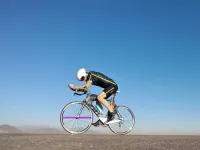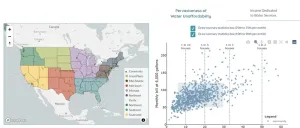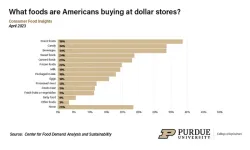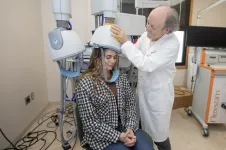(Press-News.org) Triathlons such as Ironman and Norway's Norseman competition epitomize human endurance with competitors undertaking nearly 150 miles of running, swimming and biking in grueling conditions.
But behind the training and resilience may be basic rules of ecology that help determine the victor long before contestants leave the starting line, according to research from Dartmouth.
An analysis of nearly 200 Ironman contestants over two decades suggests that performance — specifically in the marathon portion of the event — is linked to how an athlete’s physique is adapted to shedding or retaining heat in certain climates.
Published in the journal PLOS ONE, the study found that taller, leaner runners with long limbs tended to excel in Ironman events held in warm climates, while marathoners with stockier builds and shorter limbs fared better in colder climates. This physiological advantage was detected in men, but not in women.
Study author Ryan Calsbeek, a professor of biological sciences at Dartmouth, said the study is among only a few that connects human physiology to what are known as Bergmann’s and Allen’s rules, which predict how animal species are distributed across various climates.
Named for the 19th-century biologists Carl Bergmann and Joel Asaph Allen, the rules dictate that overall body size of animals — as well as the length and thickness of their limbs — correspond with climate. Cold-adapted species tend to be burlier with thicker, shorter limbs to limit heat loss, while their sleeker counterparts in hotter climes are built to keep cool efficiently.
These rules, however, are less understood in humans. A small number of studies from the mid-20th century suggested a link between physiology and climate, with people from cold or high-altitude regions having proportionately stockier builds.
The study in PLOS ONE, Calsbeek said, is among the first to suggest that human physiology may be adapted to climate to optimize physical performance. "This study shows that variation in running performance among male triathletes is consistent with both Bergmann’s and Allen’s rules," he said.
"That suggests that global patterns of temperature and climate may have shaped human body types to look and perform the way they do. These patterns that determine differences in body shape among species around the planet may also influence performance in Ironman triathlons and other endurance sports," Calsbeek said.
Calsbeek examined 171 triathletes who competed in at least two Ironman events — one in a hot location and one in a cold climate — between 2001 and 2021. The wealth of photos for Ironman events allowed Calsbeek to use digitizing software to measure competitors’ morphology based on pictures from the bike portion of the competition. Although bikes come in many sizes, wheel diameters are identical, which gave Calsbeek a size standard for measuring athletes from photos.
A past Ironman contestant himself, Calsbeek chose to study the triathlon because the different events provide a natural control to studying how physiology determines performance. Swimming is an activity humans are not evolutionarily developed to perform and cycling is aided by technology. A person’s performance in those events can be weighed against their aptitude at running to flesh out the influence of body type.
"A triathlon is a great human system to study because there is one event, running in particular, that we know to be important in the evolution of humans and two events — swimming and cycling — that are not, so there's a great natural control," Calsbeek said. "Male triathletes exhibited the most significant difference in performance based on physiology and the effect was most prominent in the run."
The lack of a significant effect of physiology on the performance of women triathletes could come down to evolution, Calsbeek said: "This effect is likely seen only in males because natural selection acted on running performance in males to be persistence hunters."
Calsbeek was inspired to conduct the study after observing that the three-time winner of the Norseman triathlon, Allan Hovda, was stockier and shorter than one may imagine a victorious triathlete being, he said. "I wondered if there was something about body shape that allowed him to do better in the cold and thought about the role temperature might play for this one guy who doesn't look like your standard endurance athlete."
The findings suggest that aspiring endurance athletes may want to consider venues in climates for which their physiology is naturally attuned, Calsbeek said.
"This study included a broad sample of athletes to account for motivation and training, but the link between performance and physiology was statistically significant in spite of those factors," Calsbeek said. "People attempting a personal best time can think about race locations and average temperatures to pick a venue based on how their body type is adapted to perform."
The paper, "Ecological rules for global species distribution also predict performance variation in Ironman triathletes," was published by PLOS ONE May 10, 2023.
###
END
Built to outlast: Body type may give athletes upper hand in certain climates
Study links human athletic performance to ecological rules of physical adaptation to climate
2023-05-10
ELSE PRESS RELEASES FROM THIS DATE:
Coping Under COVID: Study provides lessons from the pandemic on how to cope with large-scale traumatic events
2023-05-10
A new study in the journal PLOS ONE examines how individuals coped with stressors during the COVID-19 pandemic and which strategies were associated with higher quality of life.
The study’s findings provide important insights for both individuals and institutions as they prepare for and respond to future large-scale traumatic events. It was based on responses from more than 1,000 Americans on their experiences and behaviors during the pandemic.
The research found that problem-focused and emotion-focused coping strategies were associated with higher quality of life, while avoidant coping had a negative correlation.
Problem-focused coping involves ...
MD Anderson research highlights for May 10, 2023
2023-05-10
HOUSTON ― The University of Texas MD Anderson Cancer Center’s Research Highlights showcases the latest breakthroughs in cancer care, research and prevention. These advances are made possible through seamless collaboration between MD Anderson’s world-leading clinicians and scientists, bringing discoveries from the lab to the clinic and back.
Recent developments include a combination therapy for acute lymphoblastic leukemia, new insights into the evolution of anaplastic thyroid cancer, a promising new treatment approach for PTEN/p53-deficient pancreatic cancer, a novel pan-species artificial intelligence model to detect cancer cells, a ...
Millions of U.S. households may struggle to afford basic water services
2023-05-10
A new analysis suggests that about one in seven households across the U.S. may face financial hardship in paying for access to water and wastewater services. Lauren Patterson and colleagues at Duke University, North Carolina, present these findings in the open-access journal PLOS Water.
U.S. households pay utilities for access to water for drinking, cooking, cleaning, and sanitation, as well as for wastewater services. However, in recent years, the cost of these services has increased alongside a widening income gap, fueling affordability concerns. ...
Data from Argonne’s Advanced Photon Source provides foundation for first US approved RSV vaccine
2023-05-10
Respiratory syncytial virus (RSV) is a highly contagious disease that affects millions of people each year around the world, resulting in an estimated 160,000 deaths. In the United States, severe RSV causes 6,000 to 10,000 deaths among people 65 years of age or older.
On May 3, the U.S. Food and Drug Administration approved Arexvy, an RSV vaccine developed by pharmaceutical company GSK plc, formerly GlaxoSmithKline plc. It is the first RSV vaccine to be approved in the United States, and according to GSK’s press release, the first for older adults to be approved anywhere in the world. This is a ...
New procedure allows micro-printing inside existing materials with greater accuracy
2023-05-10
3D printers form objects by layering melted plastic or metal, but this only works on large scales. What you need to fabricate microdevices for which the layering step is not feasible? What if it were possible to print directly into the bulk of an existing three-dimensional material?
The research groups of Lynford Goddard and Paul Braun, professors at the University of Illinois Urbana-Champaign, have been collaborating to develop such a process. They use the technique of multiphoton lithography to print inside an existing ...
Purdue April Consumer Food Insights report explores role of dollar stores in food landscape
2023-05-10
Purdue April Consumer Food Insights report explores role of dollar stores in food landscape
A market for an expanded grocery selection at dollar stores potentially exists, especially with consumers who live less than 10 minutes away, according to data reported in the April Consumer Food Insights report.
The survey-based report out of Purdue University’s Center for Food Demand Analysis and Sustainability assesses food spending, consumer satisfaction and values, support of agricultural and food policies, and trust in information sources. Purdue experts conducted and evaluated ...
Using reflections to see the world from new points of view
2023-05-10
As a car travels along a narrow city street, reflections off the glossy paint or side mirrors of parked vehicles can help the driver glimpse things that would otherwise be hidden from view, like a child playing on the sidewalk behind the parked cars.
Drawing on this idea, researchers from MIT and Rice University have created a computer vision technique that leverages reflections to image the world. Their method uses reflections to turn glossy objects into “cameras,” enabling a user to see the world as if they were looking through the “lenses” of everyday objects like a ceramic coffee mug or a metallic ...
Stimulating hope: Personalizing treatment options for depression
2023-05-10
Artificial intelligence. Gene editing. mRNA vaccines. It’s safe to say the past few decades have felt like the next big wave of medicine. However, what continues to be needed in virtually every field is a personalized approach to care.
That’s certainly needed when it comes to using transcranial magnetic stimulation (TMS) to treat depression, said Medical University of South Carolina Distinguished University Professor Mark George, M.D.
TMS uses a magnet to increase brain activity in ...
Gene p16 drives colorectal cancer emerging as a target for potential therapies
2023-05-10
Colorectal cancer is the fourth most common and second deadliest cancer. How colorectal cancer develops is not well understood, but a team led by researchers at Baylor College of Medicine reports in the Journal of Experimental & Clinical Cancer Research that silencing the gene p16, even though the DNA itself does not change, can drive colorectal cancer progression in animal models. The researchers also revealed a strategy that reduced tumor growth and improved survival in tumor-bearing mice, opening new possibilities for future targeted therapies in patients with gene p16 alterations.
“Years of research have shown ...
New database offers insight into consequences of language loss
2023-05-10
New database offers insight into consequences of language loss
Languages, like animal species, can go extinct. More than half of the world’s approximately 7,000 signed and spoken languages are currently endangered. And without intervention they are likely to become extinct, meaning nobody will speak or sign them any longer.
While language loss is happening across the world, the costs vary strikingly in different places, according to a new study co-authored by Yale linguist Claire Bowern. Regions where all Indigenous language are endangered — including parts of South America and the United States — ...
LAST 30 PRESS RELEASES:
NTIDE: Disability employment holds steady after data hiatus
Social lives of viruses affect antiviral resistance
Dose of psilocybin, dash of rabies point to treatment for depression
Helping health care providers navigate social, political, and legal barriers to patient care
Barrow Neurological Institute, University of Calgary study urges “major change” to migraine treatment in Emergency Departments
Using smartphones to improve disaster search and rescue
Robust new photocatalyst paves the way for cleaner hydrogen peroxide production and greener chemical manufacturing
Ultrafast material captures toxic PFAS at record speed and capacity
Plant phenolic acids supercharge old antibiotics against multidrug resistant E. coli
UNC-Chapel Hill study shows AI can dramatically speed up digitizing natural history collections
OYE Therapeutics closes $5M convertible note round, advancing toward clinical development
Membrane ‘neighborhood’ helps transporter protein regulate cell signaling
Naval aviator turned NPS doctoral student earns national recognition for applied quantum research
Astronomers watch stars explode in real time through new images
Carbon-negative building material developed at Worcester Polytechnic Institute published in matter
Free radicals caught in the act with slow spectroscopy
New research highlights Syntax Bio’s platform for simple yet powerful programming of human stem cells
Researchers from the HSE University investigated reading in adolescents
Penn Nursing study: Virtual nursing programs in hospitals fall short of expectations
Although public overwhelmingly supports hepatitis B vaccine for a newborn, partisan differences exist
DFW backs UTA research to bolster flood resilience
AI brain scan model identifies stroke, brain tumors and aneurysms – helping radiologists triage and speed up diagnoses
U.S. News & World Report gives Hebrew Rehabilitation Center highest rating
Optica and DPG name Antoine Browaeys 2026 Herbert Walther Award recipient
The presence of a gun in the home increases the risk of suicide by three to five times
PFAS exposure and endocrine disruption among women
Vaccines and the 2024 US presidential election
New approach narrows uncertainty in future warming and remaining carbon budget for 2 °C
When pregnancy emergencies collide with state abortion bans
American College of Cardiology supports front of package nutrition labeling
[Press-News.org] Built to outlast: Body type may give athletes upper hand in certain climatesStudy links human athletic performance to ecological rules of physical adaptation to climate






